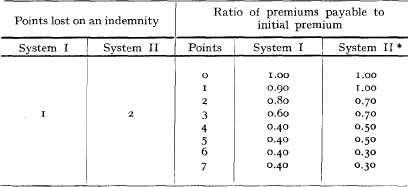Published online by Cambridge University Press: 29 August 2014
According to the provisions of the Swedish tables of rates the premium payable on a certain policy both for Third Party Liability and for Car Damage Insurance (without clause for particular self retention) is equal to the initial premium reduced with regard to points earned as related to years with no indemnities. One such point is earned for each year during which no indemnity has been paid on the policy; upon an indemnity one or two points are lost. The detailed rules for the reduction have been altered from time to time, the existing rules have been valid from the year 1952, these rules will here be called system II, while system I denotes the rules valid during the years immediately previous to 1952. The systems are described in the following table.

The probabilities for the occurrence of a claim and for the occurrence of a lapse for a policy can be considered functions of two variables, the points obtained in the bonus scale, b, and the “duration” i.e. the time elapsed since the policyholder signed his first policy, τ. For simplicity two kinds of models have been constructed, one assuming the probabilities to depend only on τ, the other assuming the probabilities to depend only on b.